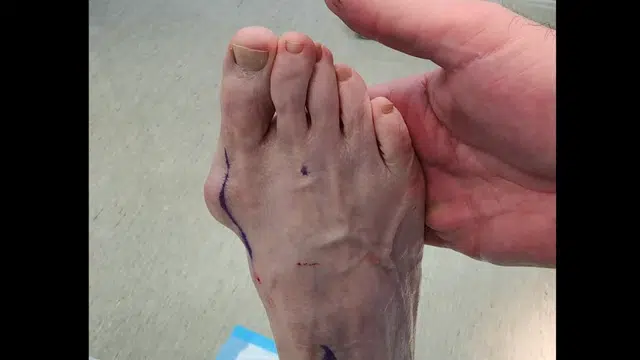What Are Bunions?
The bony protrusions formed at the base of the toes are commonly known as bunions. In medical terminology, these are called hallux valgus. In this condition, the big toe is often inclined towards the other toes.
Bunions are more common in women than men due to genetics, footwear, and other foot conditions. This condition can lead to extreme discomfort, excruciating pain, and functional limitations. Concerned by these symptoms, many people seek bunion correction procedures. The surgical procedure is known as metatarsal osteotomy or bunionectomy.
This article will guide you through the causes, correction options, and other important details. Read on to explore all the information you need to know.
Symptoms of Bunions
There are some common symptoms associated with bunions, including:
- Pain
- Swelling
- Discomfort
- Soreness at the base of the big toe
- Difficulty walking
- Limited mobility
- Visible bump
Alongside these symptoms, people with bunions may experience redness and difficulty wearing certain types of shoes.
Causes of Bunions
Some common causes of bunion development include genetic disposition, wearing tight shoes, and certain medical conditions like arthritis. Whatever the reason, the condition tends to worsen over time.
How to Correct Bunions
We refer to treatments to reduce pain and improve foot function when discussing correcting bunions. The goal of bunion correction is to restore the proper alignment of the toe.
The course of treatment and its effectiveness depends on the severity of the bunion. There are both surgical and non-surgical options for bunion correction.
What Is a Bunion Correction Operation?
A bunion correction operation, or bunionectomy, is a surgical procedure that involves the realignment of tendons, ligaments, and bones to correct the deformity of the toe.
Bunion Correction Surgical Options
Bunion correction surgery offers several techniques depending on the severity of the condition and the patient’s needs. Some of its procedures involve minimally invasive techniques while some are more vigorous.
Regardless of the type the purpose of the surgery is to minimize the pain and release tension from the soft tissues that often become tight because of bunions.
Also the technique that has to be used in the surgery is decided that targets different aspects of bunion deformity.
There are several surgical techniques available for the treatment of bunions. Some of them include:
- Lapiplasty: A minimally invasive technique combined with other corrective methods used to address the root cause of the bunion. This procedure is often used for severe cases.
- Arthrodesis: The technique is used for more severe cases where the joint is significantly damaged. It involves the fusion of the joint at the base of the toe to provide stability. Also, thus eliminating movement and thus minimizing pain.
Although, it helps in pain reduction yet it may cause restricted mobility.
- Osteotomy: There are various types of osteotomies, including proximal, distal, and interphalangeal. This procedure involves cutting and realigning the bones to correct the deformity. Types of osteotomies include:
- Chevron Osteotomy: Used for moderate bunions, a V shape cut is made at the distal (end) portion of the metatarsal bone to realign the toe joint. This method allows for precise correction maintaining the natural foot shape.
- Scarf Osteotomy: The technique involves making a Z-shaped cut along the length of the metatarsal bone, which helps in providing greater stability and allows for significant realignment. The technique is considered more complex but effective for treating larger bunions which can cause significant pain and mobility issues.
- Soft Tissue Release: In this procedure, the surgeon releases stretched or tight tendons around the bunion to improve alignment. The procedure is combined with an osteotomy or exostectomy to make sure that the bone and soft tissues are both treated for correction.
Bunion Correction Without Surgery
Patients often ask healthcare providers, “Can bunions be corrected without surgery?” Although surgery is considered the most effective and efficient way to treat bunions, there are non-surgical options available, such as:
- Splints or Braces: These are used to straighten and reduce the angle of the big toe.
- NSAIDs (Non-Steroidal Anti-Inflammatory Drugs): Over-the-counter medications can help manage pain and discomfort.
- Orthotics: Customized shoe inserts that help distribute pressure and reduce pain.
What Are Bunion Correction Devices?
Bunion correction devices are non-surgical tools designed to ease pain, improve toe alignment, and slow the progression of bunions. These devices offer support, reduce pressure, and help manage symptoms. Some examples include:
- Bunion splints
- Toe separators
- Bunion pads
Bunion Correction Sandals
Bunion correction sandals are specifically designed footwear to support and reduce pressure caused by bunions. These sandals feature wide toe boxes, cushioning, and supportive arches to improve foot alignment and reduce pressure, pain, and discomfort. They help prevent further advancement of bunions while offering daily wear comfort.
FAQs
Common causes of bunions include genetics, wearing ill-fitting shoes, foot injuries, and certain medical conditions like arthritis. It is highly advisable to address the condition early, as it can worsen over time.
Surgery is often recommended when non-surgical treatments fail to relieve the pain. The severity of the pain is directly related to restricted mobility and extreme discomfort.
Bunions can recur if proper precautions are not followed. These precautions include wearing appropriate shoes and maintaining good foot health.
Risks associated with bunion surgery may include infection, nerve damage, and delayed bone healing. These risks can be minimized by following your doctor’s advice and taking preventive measures.
You can prevent bunions from worsening by wearing shoes with wide-toe boxes and using bunion pads. Regular foot exercises can also help.
Common surgical procedures for bunion correction include Osteotomy, Exostectomy, Arthrodesis, and the Lapidus procedure. The appropriate procedure is determined based on the severity of the bunion.
Conclusion
Bunion correction procedures offer relief from the discomfort and pain caused by bunions. These procedures restore foot alignment and improve the quality of life. Working with a qualified healthcare provider is essential to ensure you receive the best surgical or non-surgical treatment.
It is on the recommendation of the Doctor whether he suggests an invasive surgical approach or a non-surgical course of treatment.
Understanding your options and taking preventive measures is crucial to enjoying long-lasting relief and healthier feet.


